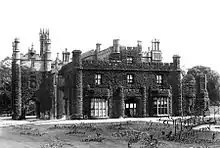Rood Ashton House
Rood Ashton House was a country house in Wiltshire, England, standing in parkland 0.5 miles (0.80 km) northeast of the village of West Ashton, near Trowbridge. Built in 1808 for Richard Godolphin Long, it was later the home of the 1st Viscount Long (1854–1924).

History
Viscount Long's great grandfather Richard Godolphin Long commissioned architect Jeffry Wyattville to build the house in 1808, replacing an earlier mansion on the estate.[1] It was altered and extended in 1836 by Thomas Hopper,[1] who incorporated some panelling and other material brought from another Long family property, Whaddon House, which had been rescued from a fire there the previous year.
The estate was originally purchased by Edward Long of Monkton in 1597. In the 19th century a considerable amount of money was spent on improving its agriculture, but the Long family saw little return for their expenditure, and the changes in taxation on agricultural land brought about by the Lloyd George government made it financially unviable.
During the residence of Walter Long, 1st Viscount Long the house was visited by members of the British Royal Family, including the Prince of Wales, later Edward VIII.[2] In 1914, during the First World War, Lord Long offered Rood Ashton and another of his properties, Culworth House in Northamptonshire, for use as convalescent homes for wounded soldiers and sailors.[3]
Auction
The house and the remaining 4,100 acres (17 km2) were put to auction by Lord Long's executors in February 1930, six years after his death. The estate included 17 farms, 21 small holdings, 100 cottages, two public houses including The Long's Arms at Steeple Ashton, and a square mile of woodland. 2,500 acres (10 km2) were purchased by a syndicate of his tenants,[4] ending 333 years of continuous ownership by the Long family.
Decline
The house was used as military accommodation and a hospital during World War II. In the 1950s it was advertised for sale again, and the agent's details listed eleven principal bed and dressing rooms, a further thirty five bedrooms, six bathrooms, two lodges, stabling, parkland, a lake and farm of 248 acres (1.00 km2) with farmhouse and buildings, all for £35,000. The new owner stripped the house of all its assets: the lead roofing and all internal panelling, fireplaces etc., were put into containers and shipped to the United States, after which time the house, now a roofless shell, became derelict.
When Pevsner visited in the late 1950s or early 1960s he described the house as "now gutted and a ruin ... on a vast scale, and most impressive in its present state".[5] In the 1970s the building was demolished except for the north wing, with eight bedrooms for servants, which has been restored with reclaimed timbers, and is now a private residence.[6] Built in limestone ashlar, these remains have one and two storeys, and a square corner tower has three storeys and two octagonal corner pilasters, rising to turrets linked by a battlemented parapet.[1] In 1975 the building was designated as Grade II listed.[1] In March 2012 the property was on the market for an asking price of £2,650,000.[7]
Associated buildings
A short distance northeast of the house is a stable block with courtyard, carriage house and lodges. In stuccoed brick and matching the style of the house, the block was probably designed c.1830 by Hopper.[8]
A former lodge is half a mile northwest of the house, at an entrance (no longer in use) from what is now the A350. It is an imitation of a castle, with an arched carriage entrance, battlements and two three-storey towers, one square and one round. It is probably contemporary with the 1836 alterations to the house.[9]
At the southwest entrance to the grounds is a lodge designed by T. H. Wyatt,[1] and nearby is West Ashton's parish church, St John's (1846), which contains the Long family crypt.[10]
References
- Historic England. "Rood Ashton House (1252698)". National Heritage List for England. Retrieved 4 November 2020.
- Memories, Autobiography by Walter Hume Long – 1923
- The Times, 13 August 1914; Issue 40603
- The Times, 13 February 1930; Issue 45436
- Pevsner, Nikolaus; Cherry, Bridget (revision) (1975) [1963]. Wiltshire. The Buildings of England (2nd ed.). Harmondsworth: Penguin Books. p. 559. ISBN 0-14-0710-26-4.
- Wiltshire Times, 12 April 2002
- "6 bedroom detached house for sale". Rightmove. February 2012. Retrieved 22 May 2020.
- Historic England. "Rood Ashton Lodge (1252835)". National Heritage List for England. Retrieved 4 November 2020.
- Historic England. "Castle Lodge (1252817)". National Heritage List for England. Retrieved 4 November 2020.
- Historic England. "Church of St John the Evangelist (1262135)". National Heritage List for England. Retrieved 4 November 2020.
